► How to import a Fiat 126 to the UK
► Mark Walton goes classic shopping
► But will the air-cooled mini make it back?
Rome was a mistake. Any classic car owner could have told me – the traffic, the summer heat, it was asking for trouble. But I was too romantic, too enthusiastic; I had this picture in my mind, of my little Fiat driving around the Colosseum with Italian policemen waving at me, like a scene from a 1970s Cornetto advert.
Instead, Rome was hell: one-way streets, traffic lights every 20 metres, and the Carabinieri were in no mood for cheap strawberry ice-cream. My little air-cooled two-cylinder started to overheat, then the gearbox turned into a plate of overcooked spaghetti – no matter how much I stirred it, I couldn’t find first or third. Setting off in second gear worked for a while, until I stalled at some lights and couldn’t re-start. Glumly, I pushed the car out the way, got the warning triangle out, and waited for everything to cool down. Japanese tourists instantly started taking photos of it. I could have sold postcards.

Yes, definitely wishful thinking, coming here; but then this whole trip was built on blind, almost pathological optimism. Buying a 1970s Fiat 126, unseen? From a man I’d never met before in Naples? Driving it back to the UK, over the Alps, with little more than a Haynes manual and a pair of pliers? That’s not just optimistic, it’s laughable! Naive! Irresponsible!
Actually, it sounds cool. When do we leave?
Woah! First we need some back-story. Like, why a Fiat 126? Simple, because I had one when I was a student, an air-cooled 650 from the early 1980s. I loved that car, and learnt a lot about engines with it. The 126 is so basic, it’s like a training model for would-be AA patrolmen: two cylinders, three wires, about four moving parts.
That car died years ago, of course, but I’ve been feeling this growing nostalgia for the 126 recently. As the boxy replacement for the original 500, it never achieved the same cult status as its loveable forebear but its success in the UK during the 1970s and ’80s means many remember it fondly. Editor Phil McNamara was driven to school in one.
It’s also one of those cars that’s completely disappeared from our roads. When did you last see one? Yes, there are a few later, water-cooled examples, the 126 Bis (built in Poland under licence). But earlier cars? You’re more likely to see a ’70s Countach than an air-cooled 126. Frankly, I’d be more excited by the Fiat.
How to buy a Fiat 126
So, I decided to buy one in Italy, before Brexit made the process a bureaucratic nightmare. That doesn’t sound too stupid does it? Or does it? Actually, maybe it does.
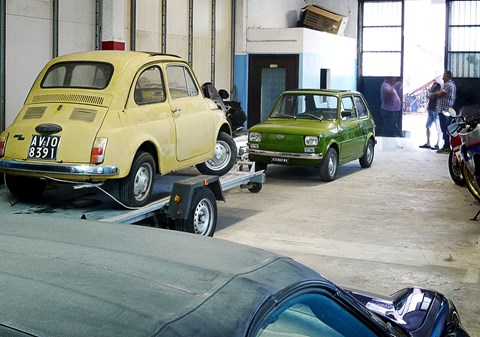
Finding cars to buy is easy – just search www.subito.it, a cross between Italian eBay and Autotrader, and you’ll find loads of classic 126s still pottering around Perugia, Pescara and Palermo. The next step – communicating with the vendors – is trickier. As I don’t speak Italian I was at the mercy of Google Translate, and how would you react if you received a text from a stranger saying, ‘I ask from UK, I am admiring machines, I want to divert your 126 home.’
Finding the exact model wasn’t easy either. I wanted a ‘prima serie’ car from 1972 to 1977, before the rubber-bumper facelift. That means chrome bumpers, ‘moon’ wheels and the original 594cc engine, bursting with 23bhp – basically a rebodied Fiat 500. But also, I wanted a folding fabric roof. This optional ‘tetto apribile’ is incredibly rare on early cars, even in Italy. In the weeks I was looking, I found only three for sale. One was too expensive. The second vendor replied, ‘Please don’t call me again. I am not interested in your proposal. It clearly sounds like a fraud’. So that was a ‘no’.
But the third… this was going to be my car, I knew as soon as I saw it. It was being sold by a guy called Antonio in Piedimonte Matese, near Naples. I texted him, and when he replied, ‘WhatsApp ok?’ I knew the game was on.
I got lucky with Antonio. Through WhatsApp we communicated every day, he replied promptly to my questions, sent pictures of the car and the documents, and he seemed completely unperturbed by my woeful Italian and my 1500-mile collection problem. He ran a B&B, and offered to pick us up at the airport and put us up for the night. His car was on sale for just over €3000 – given you can buy a decent 126 in Italy for €1000, his price reflected its rarity. In the end we agreed €2900 – about £2600.

I started making preparations. First, insurance – normally you need a UK registration plate to insure a car, so for an import you need to find a friendly insurer who’s willing to cover you using the chassis number until you get home. I called Adrian Flux, and they were helpful and happy to go ahead on that basis.
Then I bought a Haynes manual on eBay, and made a list of spares I might need: a fan belt, a set of points, a rotor arm. I contacted the UK specialist for 500 and 126 parts, ricambio.co.uk, and sought the reassuring voice of Franco Roselli. As a former 126 owner, Franco admires my plan, and emails me his own list of recommended spares, on a sale-or-return basis. His list is considerably longer than mine, with cables, condensers, a fuel pump, a coil, two fan belts, spark plugs… Oh god, there was no avoiding it: I absolutely definitely was going to break down.
Over to Italy to buy the car
Then the big day came. We were met at Naples airport by Antonio and his wife Daniella, and despite an almost complete language barrier, I loved it from the moment I landed. We climbed into his beaten-up Honda CRV and soon made a stop for a bitumen-strength thimble of coffee and sfugliatella, a traditional Neopolitan pastry filled with custard. Communication was pure Hitchhiker’s Guide to the Galaxy, each of us using our mobile translation apps. Antonio talked into his phone in rapid Italian, and out came the cold, metallic Siri voice: ‘We cannot use the highway because we have a refrigerator on our roof’. (That’s not a mis-translation, by the way. Antonio really did have a fridge on his car.)
As soon as we reached Piedimonte Matese, Antonio took me to his lock-up to see the 126. It was a great moment: the car was everything I’d hoped for, and there was no doubting the honesty and enthusiasm with which Antonio talked about classic Cinquecentos, his hobby restoring them, and his delight at finding this green 126, covered in dust, abandoned in an underground car park in Naples. He tracked down the owner, bought the car and lightly restored it, including a respray. It’s not concours, but it’s straight and clean, with just 37,000km on the clock. When it started, that familiar, wheezy duffa- duffa-duffa exhaust note transported me back 20 years.
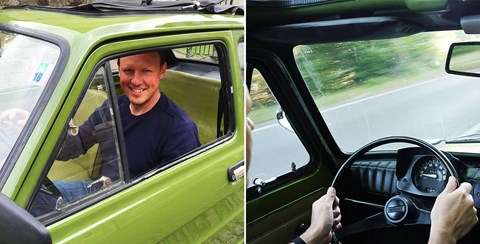
Next morning we did the paperwork, which I’d been warned could take days. But – just as Antonio had promised – it took a few hours. Rather than waiting for a local notary to sign the papers (see How to import a car from Italy below), we went to the ‘Agenzia Automobilistica’ in town, and completed everything for a €200 fee.
Before I knew it, it was time to leave. After warm goodbyes with, yes, a hint of bewilderment, Antonio and Daniella waved us off, and we headed north. How to describe those first blissful miles? Rolling through the Italian countryside, engine chattering, sun flashing through the open roof – if ever there was a car that proves you don’t need horsepower to have fun, it’s the 126. Its cruising speed is about 43mph, but there’s such a lively connection between the slender steering wheel and those little front wheels, it feels energetic and entertaining.
Still, fears loom like dark clouds in my mind. Hitting the slightest incline is like driving into treacle – will it actually make it over the Alps? And with our uphill-downhill speed averaging out at about 28mph, how many weeks will it take us to get home? And that’s without a breakdown.
Then we break down. Well, it’s not an actual broken breakdown, more a running repair. We stop for fuel and I check the engine. Horror – the whole bay is covered in steaming oil, like a deep-fat fryer has exploded in a fish and chip shop. At first I think the worst – cylinder head gasket? But it turns out to be a loose oil filler cap with a perished rubber seal. The man in the petrol station tells me there’s a Fiat garage in a nearby town, so off we trundle, feeling bad about veering off course, but how long can it take?
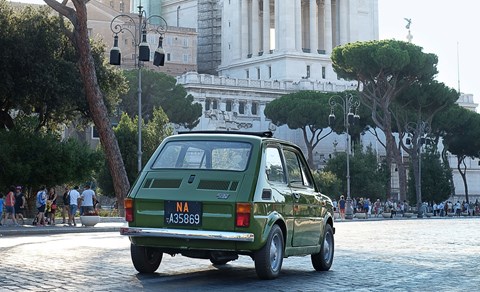
We reach the garage at 1.40pm. It’s deserted except for a woman eating a sandwich. ‘Closed,’ she says, ‘till 2pm.’ So we wait. At 2pm I go back into her office with the oil cap. ‘The mechanic starts at 2.30,’ she says. So we wait more. At 2.30pm the mechanic saunters in, takes one cursory look. ‘No. You need to drive to the next village, to Necci Ricambi’. So we drive even further off course to Necci, Ricambi, an independent motor factors. And find it’s closed, until 3pm.
After saying hello to everything wrong with the Italian economy and goodbye to our whole afternoon (though by the end we do have a shiny new oil cap) we reach Rome; and by nightfall, Siena. As I park up outside a hotel, I feel my teeth unclenching. Driving a classic is bad for the nerves.
The long journey home
Next day we start early, with the aim of reaching the Grimsel Pass in the Swiss Alps. That means 350 miles, skirting Florence, Bologna and Milan. If that sounds like a slog at 28mph, it isn’t. The 126 drums along happily, and we get a lot of love from the drivers of northern Italy, who wave and flash their lights. At least, I think it’s admiration – either that or we’re in the way.
The weather changes in Lugano and we close the fabric roof as it starts to rain hard. The passenger windscreen wiper falls off. The roads get steeper, and soon I’m grinding up a busy Swiss motorway in second gear, getting zero love from the BMW and Mercedes drivers, who are blowing their horns. I think to myself, now would be a terrible moment to get a…
Then we get a puncture. As I soon discover, you must balance the advantages of having 12-inch wheels – they’re a doddle to change – against the downside when you reach the tyre repair place. The guy laughs out loud: ‘That tyre? In stock? In Switzerland? Ha-ha-ha!’

After a hasty repair and a professional opinion that all our cracked, 1970s tyres are utterly unsuitable for the Alps, we’re back on the road and on the long, slow climb up the Gotthard Pass. Thick mist closes in, and the visibility is like peering out of a steamy shower door.
Down the other side we roll, my foot prodding the brakes for reassurance; then up and over the equally fog-bound Furka Pass. It takes hours. And then the Grimsel Pass. By now it’s pitch dark, we’re in first gear, the engine is droning loudly, and I could honestly hold a conversation with a pedestrian strolling up the hill beside me, we’re moving so slowly.
We reach the castle-like Grimsel Hospiz hotel at about 10pm, after 16 hours of non-stop driving. My arse feels like it’s been beaten with one of those spare fanbelts, and I sleep like I’ve just walked the last 350 miles.
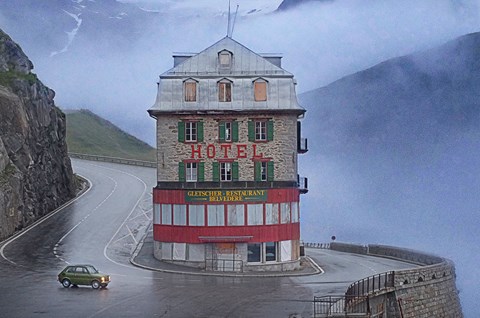
Next day we roll downhill all the way to Lake Geneva, and into France. Between Lausanne and Dijon we follow the D472, an idyllic French A-road that feels like it was built for the Fiat – winding and rolling through the countryside, suddenly 45mph feels like the ideal speed. Apart from a moment when a plug lead vibrates itself off, briefly leaving us with just one cylinder (amazingly, the car keeps going – perhaps two cylinders is excessive?).
The home straight
But with deadlines looming and the miles dribbling by, on our fourth day it’s time to hit the Autoroute and cane it. If this doesn’t kill the car nothing will… and yet, astonishingly, after hours of deadly boredom, enlivened only by the whirlwinds of spray from the overtaking trucks, we reach the Channel Tunnel, and we’re home.
Like I said, I got lucky with Antonio, and lucky with this car. I can’t believe I got back without touching any of those spares, and the air-cooled twin sounds as sweetly characterful now as the day it left the factory, 40 years ago. Of course, it failed its MOT – no surprises there – and as I write it’s still in my local garage, awaiting its first UK registration plate. But soon my exceedingly green 126 will be on the road, no doubt attracting smiles and waves wherever it goes. It’s a happy car, and I hope to keep it for many years to come.
Though I will never do a journey like that in it, ever again. I’m not that stupid.
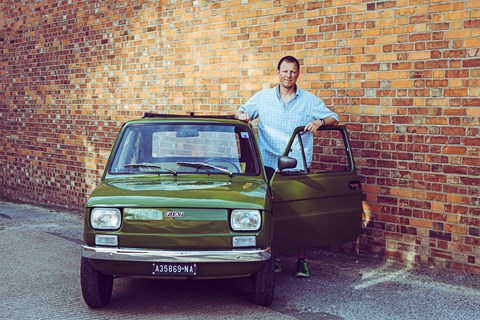
How to import a car from Italy: a guide by CAR magazine
You need five things: the original registration document (a photocopy won’t do); a Declaration of Sale, signed by a ‘notaio’ or local public-office bureaucrat. If you’re driving back, you need insurance (based on chassis number); an Italian MOT; and a registration plate. This last one is awkward. An Italian plate belongs to the owner, not the car. The new owner brings their own, but as a non-Italian, you can’t register a plate. So you either need a temporary export plate, which can take days; or you drive back on the owner’s plates, then post them back to Italy. I got lucky – instead of finding a notary, we went to the ‘auto agency’ in town. They handled the sale.
Back in the UK you have 14 days to let HMRC know you’ve imported a car, using its online NOVA service. They then let you know how much import tax you owe – but for an EU car over six months old that’s zero. Older cars don’t need type approval. You’re not allowed to drive on those Italian plates here, unless you’re driving straight to a booked MOT (I pre-booked one). Once you have your MOT you fill in a V55/5 form to register it in the UK. It costs just £55 all in.